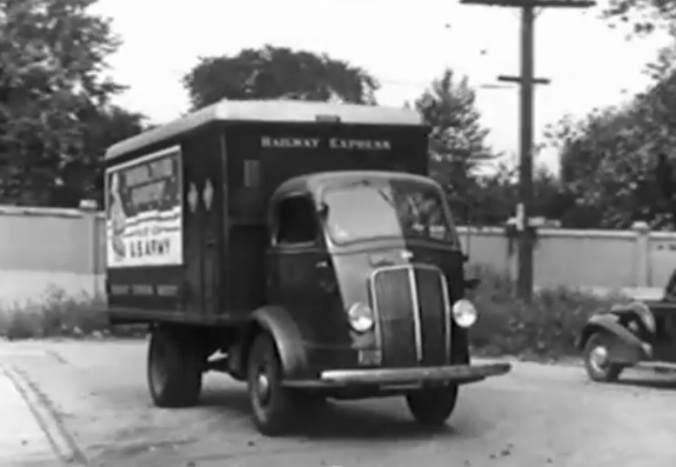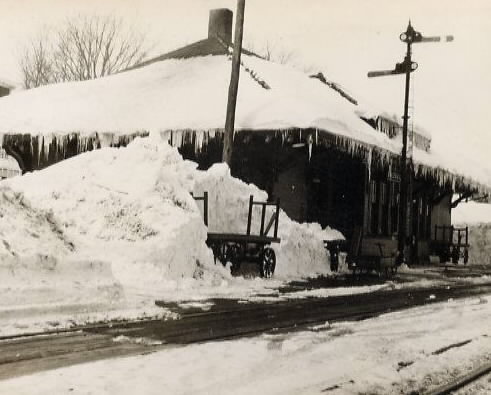

Most of the year this is a New York City GARBAGE TRUCK. But when it SNOWS, it quickly becomes a SNOW PLOW / SALT SPREADER. Imagine a “Conga Line” of these chasing you down Broadway!
 Is this the way of the future? Smaller, then even electric, garbage trucks?
Is this the way of the future? Smaller, then even electric, garbage trucks?

This rugged cross between a tractor and a truck collects dumpsters from the narrow alley ways around “Old Nice” in France
This little guy is electric too. He is used to collect from pedestrian zones.
See a film clip on the Howo factory and on the garbage truck in operation
GARBAGE TRUCKS THROUGH TIME…..TO SOME IT IS HISTORY, TRIVIA TO OTHERS
The first garbage trucks were open top dump trucks not designed specifically to haul garbage. But the open top truck let small items fly out and smells too. So in the 1920s covered body trucks were designed to handle hauling of garbage.
The manufacturer of the refuse body is usually separate from the chassis. So here are some of the companies developing refuse bodies:
1930s-1940s covered hoppers by Heil, Leach, Garwood
1920s-1950s rotary loaders by Keller & Knappisch, Garwood, City Tank
1930s to 1950s rear loader compactors by Garwood, Leach, Heil
In 1938 the Garwood Load Packer revolutionized the industry with a compactor in the truck itself.
1940s to 1950s side loader compactors by PakMor, M-B Packer
1950s to 1980s front end loaders by Dempster, Garwood, Heil The Heil Colectomatic used a combination of a lifting loading hopper and a sweeper blade to clear and compact garbage in anticipation of the next load. 1955 brought the Dempster Dumpmaster (first front loader).
Classifications of garbage trucks
* Front loaders generally service commercial and industrial sites using dumpsters (UK term is large wheelie bins).
They have large prongs on the front which are carefully aligned with arms on the dumpster. The dumpster is then lifted over the truck, until it is upside-down and the trash will then fall out into the receptacle.
* Rear loaders commonly service residential areas. They have an opening at the rear that a trash collector can throw garbage bags or empty the contents of trash cans into. The rear loader is usually equipped with some type of compactor that will compress the garbage, and move it towards the front of the vehicle.
* Side loaders are versions of either front or rear loaders that lift small trash containers or have openings on either side to deposit trash. Some side loaders are equipped with a mechanical remote-control arm that grasps a trash container such as a wheeled bin and empties it into the truck in the same manner as front loaders.
* Pneumatic collection, almost a 24 ton vacuum cleaner. On the top it has a crane with a tube and a mouthpiece that fits in a hole, usually hidden under a plate under the sidewalk. From here it will suck up garbage from an underground installation. The system usually allows the driver to “pick up” the garbage, even if the access is blocked by cars, snow or other barriers.
There are also larger trucks that carry trash over long distances, usually modified dump trucks.
Garbage trucks empty their trash in landfills or combustion facilities. Most rear loaders lift the rear section so that the garbage will spill out. Front loaders more commonly have a moving wall that pushes the garbage out. Some larger landfills tip the entire truck.
Other improvements to garbage trucks
The main difficulty with early trucks was that the garbage collectors needed to lift the trash to shoulder height. The first technique developed in the late 20s to solve this problem was to build round compartments with massive corkscrews that would lift the load and bring it away from the rear. A more efficient model was the development of the hopper in 1929. It solved this problem by developed a cable system that a could pull garbage into the truck.
In 1937 George Dempster invented the Dempster-Dumpster system in which wheeled garbage containers were mechanically tipped into the garbage truck. His containers were known as Dumpsters, so here is where that word came from.
Operators want a fully automated garbage truck that could do away with all but the driver. Some cities do have these systems, but they are generally unable to deal with unexpected situations.
As well as garbage trucks, we have heard them referred to as trash truck, waste collection vehicle, refuse truck, dustcart, or sometimes dustbin wagon in the U.K.

Not even a truck, but operated by the same department that operates the garbage trucks. This boat (and three sisters) clean the beach in Nice, France daily.
* * * * * * * * * *

Utica Number 2 Salvage Truck in 1940
***********

These DIVCO Milk Trucks are one of my favorites
* * * * * * * * * *
General Electric fire department in Schenectady, NY about 1949
***********

This 1940 Mack Tow Truck was photographed (1980’s) at the Mack Dealer in Worcester Massachusetts
***********
BEFeD BrewPub came to Nice, France.
Was easy to find! Right on the Promenade. You could see this truck (a BALILLA / FIAT) on their restaurant sign and on their delivery trucks. Alas! It is now a plain old Hard Rock Cafe.
************
 Army wreckers have a constant design over the years. Here is an M108.
Army wreckers have a constant design over the years. Here is an M108.
Built by Reo, the M108 wrecker is powered by a Reo/Continental Model OA-331, 4-cycle, in-line 6 cyl, 331 cu in gasoline engine coupled with a 5-sped synchromesh transmission and a 2-speed transfer case. With a fuel capacity of 50 gallons, it had a cruising range of 350 miles and an allowable speed of 62 mph.
***********
#2 Salvage was my favorite fire engine when I was growing up.
<> Lot of people said it wasn’t “pretty” like later fire engines. They were right. It had the “tough guy” look it deserved. When you saw it “growl” out of the Central Fire Station on Elizabeth Street, you knew to get out of its way: it had a job to do. Even the back end said it all: “KEEP BACK 200 FEET”; no cute little sign like “please don’t follow me to close”. Two great pictures of #2 Salvage. Loved how they would open the side covers on the engine so it didn’t overheat when they were working a fire.
***********

***********

* * * * * * * * * *
Fruehauf Trailers
“Singing Wheels” the rise and fall of the Fruehauf Trailer Company
The Fruehauf Trailer Company was an American corporation engaged in the manufacture and sale of truck-trailers with headquarters located in Detroit, Michigan.”How important is Fruehauf Trailer Company in the trailer industry? To say it is the General Motors of the business understates the case. Not only was Fruehauf the biggest firm in the field, it sold more than all the others put together”. Picture from Ford Museum in Dearborn, MI.
***********
Garage Depannage Millo near Nice, France has several wreckers. This Renault is their “big guy”.
Seen it pick up a bus like it was a toy.
**********

*** * * * * * * *

Snow and Railroads
* * * * * * * * * *

Food Distributor for organic and natural products. Wholesale distribution throughout North America. We are a broker for organic and natural products. We specialize in locating organic products you sometimes can’t get from your local distributors. We set you up with a relationship with a supplier.
* * * * * * * * * *

There is a “Snow Belt” in New York State that runs above Syracuse and Utica. It goes East from Oswego to at least Boonville. Here’s the station at Boonville.










You must be logged in to post a comment.